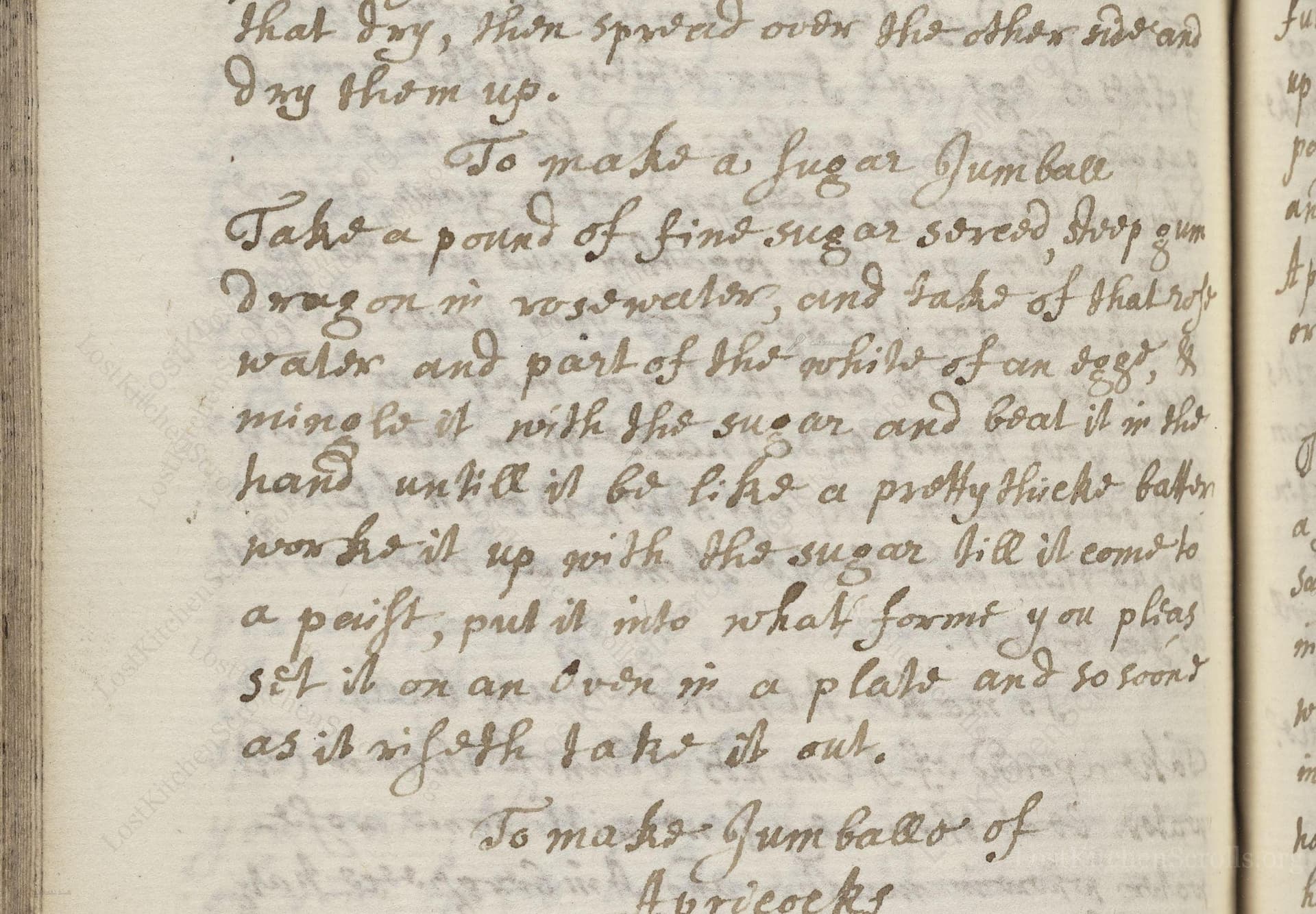To Make A Sugar Jumball
From the treasured pages of Manuscript cookery book
Unknown Author

To Make A Sugar Jumball
"Take a pound of fine sugar sieved, three drops of Dragon in rosewater, and take of that rosewater and part of the whites of an egg, & beat it with the sugar and beat it in the hand untill it be like a pretty thicke batter worke it up with the sugar till it coms to a paist, put it into what forms you pleas set it on an oven in a plate and so soone as it riseth take it out."
Note on the Original Text
Early recipes like this one are more poetry than science, relying on experiential cues—'beat it in the hand,' 'till it coms to a paist,' and 'so soon as it riseth take it out.' Spelling is loose ('paist' for paste, 'coms' for comes), and measurements are approximate: a 'pound' is the only set quantity, while much is determined by texture and look rather than timing or temperature. Instruction is direct and assumes familiarity: the reader is expected to know how to mix by hand, knead a paste, and judge when something 'riseth.' This delightful looseness invites creativity, yet also challenges the modern cook to interpret with both intuition and precision.

Title
Manuscript cookery book (1680)
You can also click the book image above to peruse the original tome
Writer
Unknown
Era
1680
Publisher
Unknown
Background
A tantalizing window into the kitchens of yesteryear, this late-17th century collection presents recipes and culinary wisdom meant to delight and surprise even the most discerning of historical gourmands.
Kindly made available by
Folger Shakespeare Library
The recipe dates from late 17th-century England, around 1675-1686, a period renowned for elaborate confectionery in well-off households. Jumballs—sometimes spelled "jumbles" or "jumbals"—were originally dense, biscuit-like confections, but here they shift into more meringue-like, sugary treats, intended for special occasions or as gifts. Recipes like this show the blending of exotic imports (rosewater, sometimes dragon’s blood, a fantasy ingredient or fragrant resin) with English tastes. They offer a playful window into the early modern kitchen, where cooks experimented with textures, flavors, and forms for the pleasure of their guests.

In its original context, the recipe would have been prepared with hand-carved wooden spoons, a wide mixing bowl (likely earthenware or pewter), and hands for kneading and 'beating.' The oven would be a wood-fired masonry affair, its heat gauged by feel, and the jumballs likely baked on a metal plate or shallow pan. A sieve or fine cloth would have been used to ensure the sugar was finely ground, while rosewater would be stored in glass phials or ceramic bottles.
Prep Time
15 mins
Cook Time
10 mins
Servings
20
We've done our best to adapt this historical recipe for modern kitchens, but some details may still need refinement. We warmly welcome feedback from fellow cooks and culinary historians — your insights support the entire community!
Ingredients
- 1 pound (about 2 cups) fine white sugar, sifted
- 3 drops dragon’s blood resin (substitute: rose essence or omit)
- 2 tablespoons (1 fl oz) rosewater
- 1 medium egg white (use about 1 tablespoon)
- Edible gold or decorative elements (optional, if desired for presentation)
Instructions
- Begin by sifting 1 pound (about 2 cups) of fine white sugar into a large mixing bowl.
- Dissolve three drops of food-grade dragon’s blood resin or, as a substitute, a few drops of rose essence, in about 2 tablespoons (1 fl oz) of rosewater.
- Lightly beat the whites of one medium egg, then combine a portion (approximately one tablespoon) of the whites with the rosewater blend.
- Gradually add the rosewater-egg white mixture to the sugar, beating with a wooden spoon or by hand, until the mixture thickens into a stif, glossy bater.
- Continue kneeding or working the mixture by hand until it forms a pliable, dough-like paste.
- Shape the paste into small rounds, knots, or any forms you like, and place them onto a baking tray lined with parchment.
- Bake in a preheated oven at around 250°F until the jumballs puff just slightly and appear set (likely 8-12 minutes).
- Remove promptly before coloring or hardening further.
Estimated Calories
90 per serving
Cooking Estimates
Preparation takes about 15 minutes, including mixing and shaping the dough. Baking takes 10 minutes. Each serving contains about 90 calories. This recipe makes 20 small jumballs.
As noted above, we have made our best effort to translate and adapt this historical recipe for modern kitchens, taking into account ingredients nowadays, cooking techniques, measurements, and so on. However, historical recipes often contain assumptions that require interpretation.
We'd love for anyone to help improve these adaptations. Community contributions are highly welcome. If you have suggestions, corrections, or cooking tips based on your experience with this recipe, please share them below.
Join the Discussion
Rate This Recipe
Dietary Preference
Main Ingredients
Culinary Technique

Den Bockfisch In Einer Fleisch Suppen Zu Kochen
This recipe hails from a German manuscript cookbook compiled in 1696, a time whe...

Die Grieß Nudlen Zumachen
This recipe comes from a rather mysterious manuscript cookbook, penned anonymous...

Ein Boudain
This recipe comes from an anonymous German-language manuscript cookbook from 169...

Ein Gesaltzen Citroni
This recipe, dating from 1696, comes from an extensive anonymous German cookbook...
Browse our complete collection of time-honored recipes



